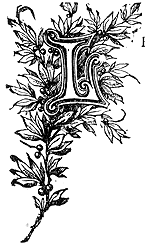
AUNCESTON is a most picturesque town, clustering on the side of a hill that slopes to the little river Kinsey; while above it rise the grand tower of its old church and the ivy-clad ruins of its ancient castle.
Its old name was Dunheved, or "the swelling hill"; its modern name alludes to its church and castle, "the church-castle-town."
It was made a free borough by Richard, Earl of Cornwall, and the townsmen hired the site of their guildhall from him at the rent of an annual pound of pepper.
Queen Mary incorporated it.
In old days Launceston possessed the privilege of sanctuary.
The ruins of the castle stand on the north side of the town, on a high hill, and cover a large extent of ground. The walls are ten or twelve feet thick; "the covered way between the walls is pierced with narrow windows, yet covers the communi-cation between the base court and the keep or dungeon, which is built on a lofty taper hill, partly natural and partly artificial, 320 feet in diameter, and very high. The keep is 93 feet in diameter" (Timbs).
"The hill on which the keep stands," says Leland, speaking of the castle in his time, "is large and of a terrible height, and the ark [keep] of it, having three several wards, is the strongest, but not the biggest, that I ever saw, in any ancient work in England."
A stronghold of much importance it must have been in the days when it was built, and long after, for Roman coins have been found among the ruins, and un doubtedly those people would have help the fortress, valuable as it was from its commanding situation near the river Tamar. It appears to have been a British stronghold, repaired and enlarged by the Normans.
At the foot of the hill on which the ruins stand is a gate-tower, which strengthened the wall that once ran round the castle hill, though now a few fragments of it alone remain. Of the inner or second wall there are many more and interesting remains. The gatehouse has an Early English archway and grooves for a Portcullis; it is in good preservation, and the ruins are kept carefully in order by the Duke of Northumberland, who is the hereditary high Constable of the castle. The north gate is also of Early English architecture. The duke has had the surroundings of the ruins and part of the old moat planted, and has given them as a public park to the town.
The building of the castle has been ascribed to William, Earl of Moreton and Cornwall, the son of Rufus's favourite, to whom 288 manors in Cornwall were given by the Conqueror. But the workmanship is of much earlier date; the keep, especially, is thought to be British.
The first event recorded of the castle is the displacing of Othomarus de Knivet, its hereditary Constable, for taking arms against William I., and the gift of it to the Earl of Moreton, who was created Earl of Cornwall at that time.
After the death of Earl Robert's son, the property reverted to the Crown, but was always given afterwards with the title, from which it was never detached. Edward III. constituted it part of the duchy.
In 1540 some leather money was found in the castle walls, but we do not know what inscriptions there were on them, as they were not preserved, nor their impressions taken. It is remarkable, however, that Edward I. used leather for coins when erecting Carnarvon Castle, "to spare bullion."
In Leland's time several gentlemen of Cornwall held their lands by castle-guard of Launeeston, being thus bound to repair and defend its fortifications.
During the civil war the castle was garrisoned for King Charles by Sir Richard Grenville, and was one of the last strongholds of the royal cause in this pact of the country; it surrendered to Fairfax in 1646.
The church of Launeeston is dedicated to St. Mary Magdalene; it a really fine building, in the Perpendicular style of arichitecture, and was erected - in the centre of the town - in 1524 by Sir Henry Trecarrel, of Trecarrel, and has been admirably restored of late years.
It has a nave, chancel, north and south aisles, and a stately west tower; on its walls are sculptured pomegranates, roses, and different shields of arms, the Prince of Wales's feathers, etc., etc.
The south porch has basso-relievos of St. Martin and St. George and the dragon. Beneath the east window is a statue of St. Mary Magdalene. Devout ejaculations in Latin are arranged on shields between the basement and the windows.
|